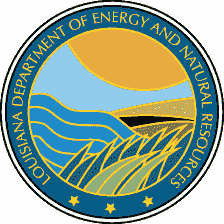Office of Conservation
First Oil Well in Louisiana
The first oil well in Louisiana was drilled in 1901 in a rice field on the "Mamou Prairie" in the community of Evangeline near Jennings.
The owner of the property, Jules Clement, had noticed bubbles rising from a spot in one of his rice fields when it flooded. With the recent discovery in Spindle Top in mind, he conducted an experiment. He stood on an old stovepipe over the bubbles, lit a match and threw it into the pipe. Gas from the bubbles ignited.
He told friends about this and word spread to Jennings, reaching the ears of several interested area businessmen. They quietly secured leases on approximately 2000 acres in the vicinity of the seepage and formed S.A. Spencer & Company.
They contacted Scott Heywood, a successful wildcatter in Texas, to see if he would be interested in their prospect. Heywood visited the area and noted that the land formations were much the same as those at Spindle Top and conducted his own tests by lighting the bubbles with matches. When it burned with a red flame, showing smoke at the top of the flame, he was convinced that it was petroleum gas.
Heywood contracted to drill two wells to a depth of 1000 feet each for an undivided one-half interest in the acreage. The contract also provided that he could organize a company to be called the Jennings Oil Company.
A drilling rig was moved from Beaumont to drill the well and drilling began on the Jennings Oil Company- Clement No. 1 on June 15, 1901. Scott Heywood was the superintendent and co-owner. Machinery was shipped from Spindle Top. The derrick was 64 feet high and the drill pipe (stem) was just ordinary line pipe.
Heywood commented that he sometimes wondered how they ever accomplished what they did in those "old days." It was 90 days of working in the hot sun, fighting mud and mosquitos. At about 250 feet there was a very small showing of oil in the mud on the top of a water sand. Around 400 feet they twisted off a string of pipe.
It was necessary to give up the hole, move over a few feet and make a new start. When the specified contract depth of 1000 feet was reached, oil had not been found.
Heywood's contract provided that his second well must be started within 30 days after the Jennings Oil Company well was finished. It seemed foolish to him to drill another well to a depth of 1000 feet to acquire his interest.
Scott Heywood proposed that Heywood Brothers obtain an agreement from Spencer & Company allowing a second well to be drilled at the bottom of the Jennings Oil Company-Clement No. 1 Well.
A joint agreement was reached between Spencer & Company, Scott Heywood, Jennings Oil Company and Heywood Brothers and the contract was signed on August 11, 1901.
Heywood Brothers was to drill to a depth of 1500 feet. If any favorable indications were found, they were to drill to a greater depth, if it was deemed advisable.
With no favorable results at 1500 feet they ran short of drill pipe.
A decision had to be made. Should the well be abandoned, or should they drill deeper?
Some of the Heywood brothers wanted to call it a day, but Scott Heywood insisted on getting more drill pipe and going deeper on his own. Alba Heywood felt that the brothers should stay with Scott as long as he wanted to drill.
Scott Heywood shipped in more drill pipe, continued to drill, and at 1700 feet struck "a very fine showing of oil in sugar sand." More pipe was sent in to finish drilling into the sand and when finished there was 110 feet of oil sand.
Casing was set with a gate valve for protection. After running the bailer the second time the well came in, flowing a solid four-inch stream of pipeline oil over 100 feet high.
The well flowed sand and oil for seven hours and covered Clement's rice field with a lake of oil and sand, ruining several acres of rice.
Oil sand piled up on the derrick floor and for about 100 feet around the derrick to a depth of over one foot.
The well finally gave one big gush of oil and sand and shut itself in, sanding up for a distance of 1000 feet in the casing.
On the evening of September 21, 1901, a farmer rushed into Jennings with the news that oil had been discovered.
Washing, bailing and flushing continued for about 30 days. If the sand could have been controlled in that well, it would have produced over 7,000 barrels per day.
One day when the 2-inch pipe was being removed from the well after washing the sand out, the well began flowing again.
Before the removal could be completed, however, the well sanded up over 1,000 feet and stuck the pipe. Failing in an attempt to fish the 2-inch pipe out, the well was abandoned.
But, the boom had begun! It brought people, money and ideas into the area, and the town of Jennings flourished.
To date, over 220,000 wells have been drilled in Louisiana. It is this first well which changed the history of our State forever.
[The above was adopted from an article by Shelia Esthay in the "Jennings Daily News."]
In north Louisiana, the Oil City Louisiana State Oil and Gas Museum reports that the first well drilled offshore was in Caddo Lake (formerly called "Ferry Lake"), the Ferry Lake No. 1 well in 1909.

